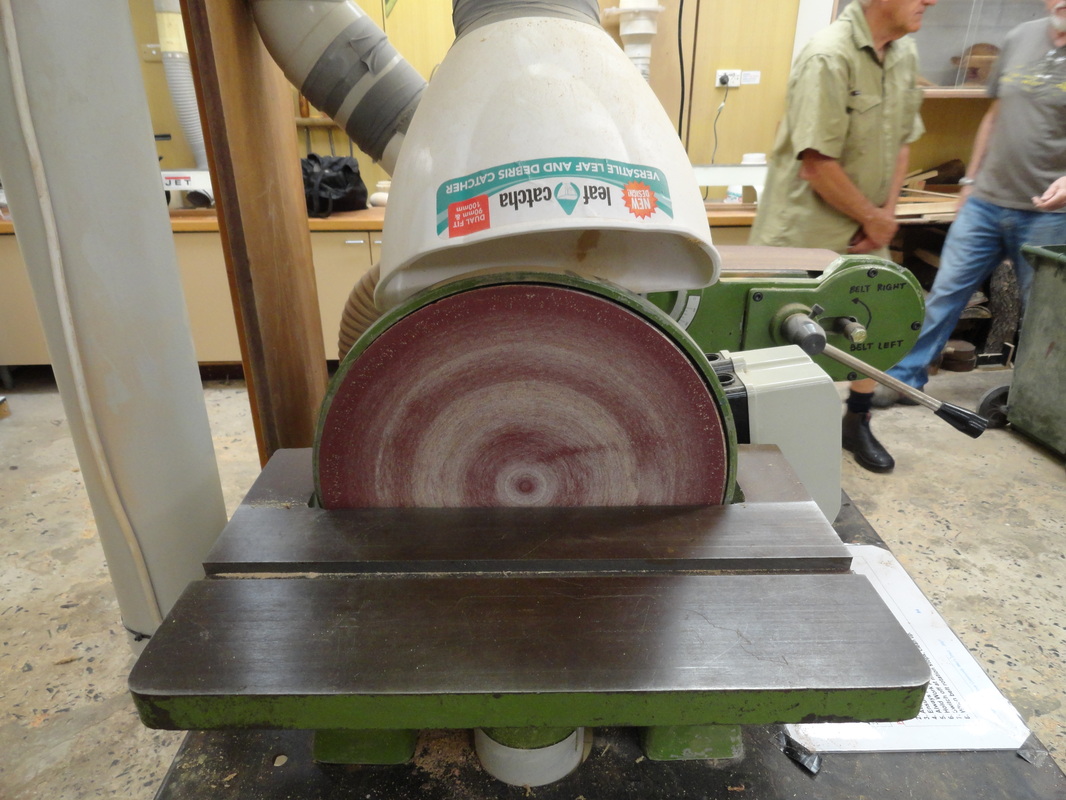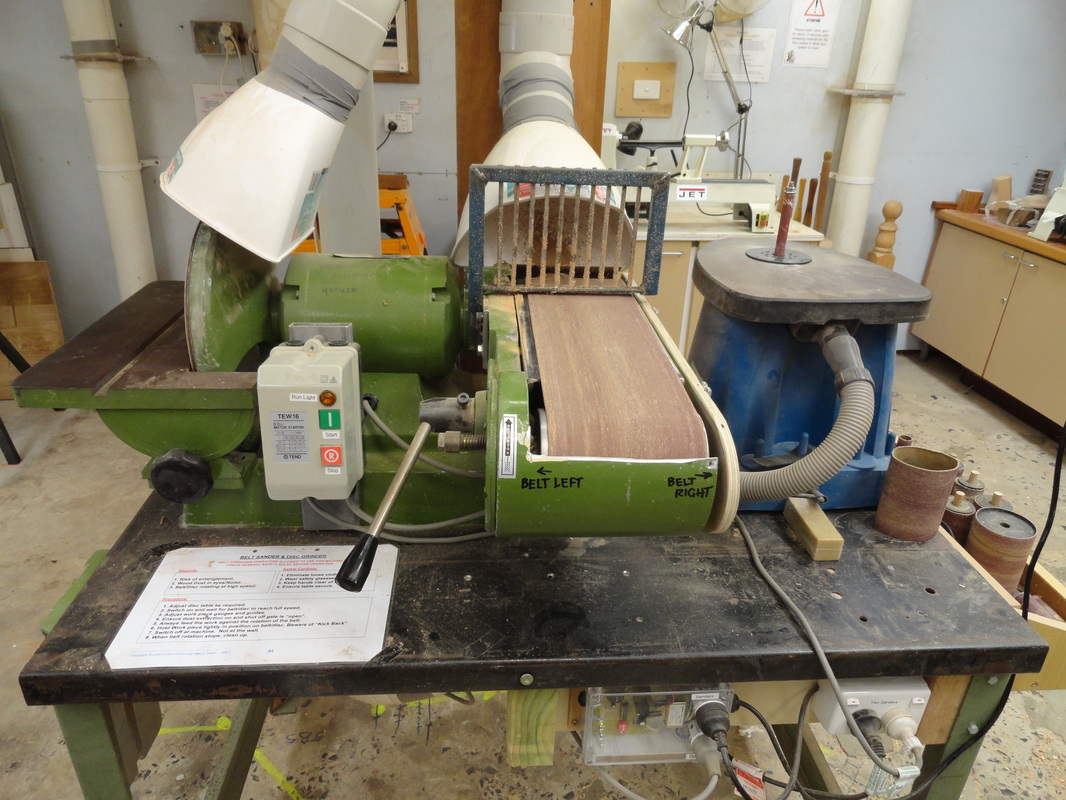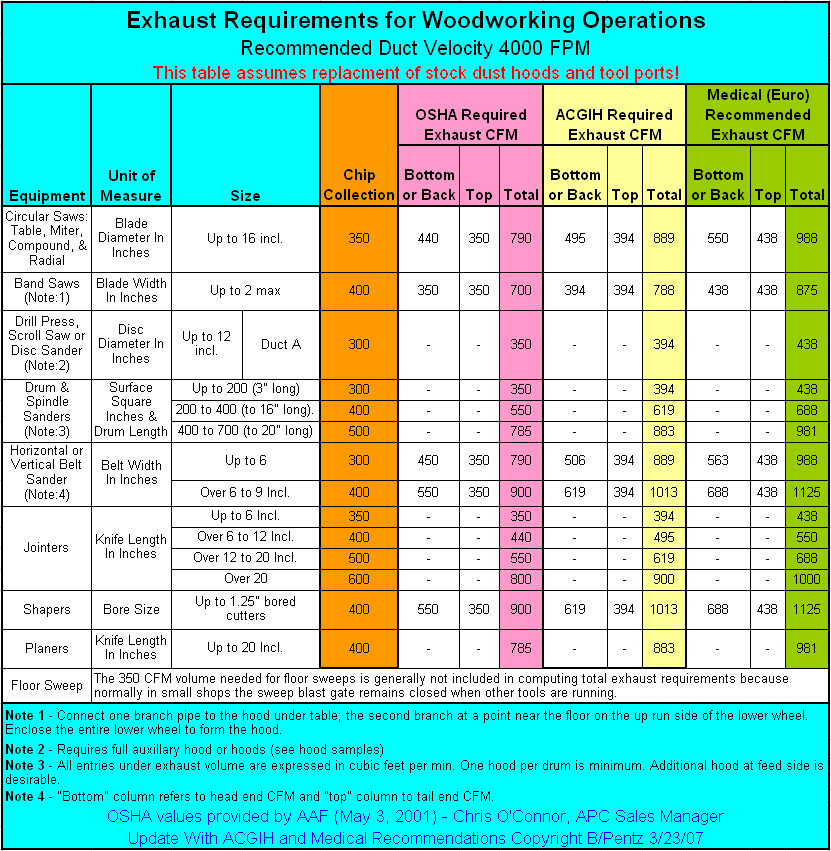 Needs Pictures: 0
Needs Pictures: 0
Results 16 to 30 of 254
-
25th October 2015, 10:49 PM #16
 .
.











- Join Date
- Feb 2006
- Location
- Perth
- Posts
- 27,785

There are many machines like your thicknesser that are impossible to fit large BMHs to and sometimes people cannot work outside with these machines.
If there is nowhere on the cabinet large enough to fit a full size BMH then opening up the dust collection ports to as much as is practical and then add a 6" BMH above the machine is about as good as can be done.
Sanders are a classic example.
Here's my sander - I opened up the original rectangular port by cutting as much as I could off (the bit I cut off is on the end of the belt) - the new port is 2x larger in area than the old one so it works a lot better but its still a problem.
Ideally I would completely ditch that port and replace it with a BMH pointing upwards at an angle of about 5 O'clock towards the end of the belt
This is on the todo list
When this sander is running the motor fan drags dust away from the belt and sprays it around the shed so another 4" flexy is attached to the top of the motor to keep that under a control - 6" BMH would be better.
Here is the disc side - this is an infinite improvement on the original since it previously had no dust extraction.
Note how I left the LHS of the ducting open to allow for airflow - a small BMH on that naked pipe is on the todo list.
This works very well. A 6" BMH at the 8 O'clock position would be better,
The Corrimal mens shed have the right basic idea with this sander it has a 4" under table extraction and a fine dust catcher above.
They did the same for the 6" wide belt sander
The one thing I would change is that instead of a leaf catcher I would recommend using a BMH.

And here is their sander - there bobbin sander loos like it could use one as well.

-
25th October 2015 10:49 PM # ADSGoogle Adsense Advertisement
- Join Date
- Always
- Location
- Advertising world
- Posts
- Many
-
26th October 2015, 02:21 AM #17
 GOLD MEMBER
GOLD MEMBER











- Join Date
- Aug 2007
- Location
- Saskatoon, SK, Canada.
- Posts
- 1,439

Bob
Would your disc sander benefit from having the edge of the slot rounded over along its length? Instead of having cut a slot in the pipe, a flap cut instead and folded over with a heat gun to make in effect a long bell mouth.
Pete
-
26th October 2015, 10:20 AM #18
 .
.











- Join Date
- Feb 2006
- Location
- Perth
- Posts
- 27,785
-
26th October 2015, 06:30 PM #19

Just an observation - in all the photos posted above by BobL of his equipment and the Corrimal mens shed setup, I did not see a single BMH of the type we are discussing in this thread.
Bob did identify that they could be used in a few places, but generally for catching the invisible dust that is already outside of the machine's cabinet.
I guess that in theory our dust collection would be better if we could fit optimised BMH's to our equipment, but in the real world this is not often practical, so we do the best we can and utilise BMH's above the machines that are troublesome in conjunction with air filters, exhaust fans etc to keep teh air clean and have a respirator for when it is needed.
Cheers
DougI got sick of sitting around doing nothing - so I took up meditation.
-
22nd November 2015, 06:16 PM #20
 SENIOR MEMBER
SENIOR MEMBER











- Join Date
- Aug 2008
- Location
- Brisbane (Macleay Is)
- Posts
- 268

Hi BobL
I was reading dougs outline of the problems fitting a suitable sized bell mouth and air inlets to a planer/thicknesser.
It occurred to me that unlike a sander or tablesaw, a planer/ thicknesser tends to produce much more chips than dust particularly when a reasonable depth of cut is involved. This is evident because many planers choke on the chips due to restrictions in the collector hoods. If so then we may not need quite so efficient dust extraction on this class of machine.
Do you have any info on whether this observation is accurate or is fine dust still a problem with these machines?
Thanks
Ron
-
22nd November 2015, 06:34 PM #21
 .
.











- Join Date
- Feb 2006
- Location
- Perth
- Posts
- 27,785

They do indeed make a lot of chips and although the proportion of fine to coarse dust tends to be less than other machines, the sheer volume of total dust they makes means they still make a lot of fine dust.
Of the machines I have tested the dustiest in decreasing order were on average
1) lathes and sanders,
2) thicknessers, planers, routers
3) saws
5) drill presses
6) Hand tools (apart from sanding which varies a fair bit)
Of course there are many factors involved.
The most critical ones is sharpness of blades.
Someone turning a pen sized object with sharp tools (no sanding) may make far less dust that a blunt table saw.
-
22nd November 2015, 07:28 PM #22

Hi Ron, this is from Bill Pentz's site http://billpentz.com/woodworking/cyc...s.cfm#Overview
This would seem to indicate that a smaller jointer needs about the same airflow to clear chips and fine dust as a tablesaw but a larger jointer needs more airflow. BIll explains this by the amount of fine dust is within certain range of percentages of the amount of sawdust produced. Jointers do generate a large volume of sawdust compared to a tablesaw.
Cheers
Doug
I got sick of sitting around doing nothing - so I took up meditation.
-
22nd November 2015, 08:23 PM #23
 SENIOR MEMBER
SENIOR MEMBER











- Join Date
- Aug 2008
- Location
- Brisbane (Macleay Is)
- Posts
- 268

Hi Doug
Thanks for the link to Bill's table. It is sometime since I have read his articles.
However looking at the table seems to support my observations. A 12 to 20" jointer produces many many times the volume of dust/chips compared to say a table saw yet the cfm recommended is 600 to 700 compared to a 1000cfm for the saw.
Also the values for sanders seem way too low. A 6" belt sander produces masses of dust much of which is very fine yet supposedly requires only slightly more air flow than the saw. Belt sanders also have a capacity to fling that dust past collectors which greatly exacebates the problem
Fortunately my planer / thicknesser has a 5 1/2 dust outlet already( its a metric machine with odd size ducting) and has room to easily expand to 6" including a bell flange. My problem is deciding whether the inlet of air is restricted. When I get a chance I will measure the airflow through my ducting with and without the duct connected to the planer. If there is serious restiction to incoming air I dont think there is much I can do to resolve the problem.
Ron
-
22nd November 2015, 08:55 PM #24

Yes I see what you mean but if you look at Bill's table it also specifies where the ports are located. For the belt sander it specifies either end of the belt which is where the belt changes direction and dumps a lot of trailing dust into the duct. That's probably why the CFM required is less than you might expect for a machine generating such a high volume of smaller dust particles.
However, if you can generate 1000 CFM to clear the invisible dust around your tablesaw you should also be able to generate 1000 CFM at your sander and jointer, (you don't use them all at once?) so unless you have a particle counter to verify that your air quality is satisfactory (and I would definitely be looking at the green column on Bill's chart) use all the available CFM you can get to ensure you get as much as possible of that invisible dust, and make sure that it is vented outside the shed.
Cheers
DougI got sick of sitting around doing nothing - so I took up meditation.
-
22nd November 2015, 09:05 PM #25
 .
.











- Join Date
- Feb 2006
- Location
- Perth
- Posts
- 27,785

I think you are looking at jointers? - if you look at planers or thicknessers they are up there with TS.
That's what my testing shows as well.Also the values for sanders seem way too low. A 6" belt sander produces masses of dust much of which is very fine yet supposedly requires only slightly more air flow than the saw. Belt sanders also have a capacity to fling that dust past collectors which greatly exacebates the problem
The chart fails to take into account another very important parameter about sanders and that is the length of the belt.
400 CFM = about 7 cubic ft per second represents a sphere with a radius of about 14" being removed every second.
If dust is generate or moved outside this sphere at a greater rate then the dust will not be collected at source
Now consider a 6" belt that is 1m long, sanding a 1m long piece of wood and collecting, 400 CFM at the usual dust collection port at the end of the belt doesn't have a hope of collecting all the dust generated. The fine dust is warm and rises off the wood well before it gets collected. The 4" dust ports at the end of belts are designed more to remove the dust from the belt (high air speed) rather than be an effective dust collector.
1000 CFM at the end of the belt is actually not that much better - the sphere per second collected is now 19" in radius - but if a bell mouth collection point is placed above and slightly to the side of the belt there is now and 38" diameter sphere of air being collected every second - now we have a chance of collecting the fine dust.
Sanding is a pest and about the best folks can do is collect what they can and then run their DC for 10-20-30 minutes after the last sanding to vent the shed.
Good exhaust fans really help.
-
22nd November 2015, 09:09 PM #26
 SENIOR MEMBER
SENIOR MEMBER











- Join Date
- Aug 2008
- Location
- Brisbane (Macleay Is)
- Posts
- 268

The issue for me is not airflow per se. I have a CV 1800 running at 60 hz with 150mm ducting to all machines. My original post was in response to the discussion about fitting bell mouth ports (150mm) to machines and there was several mentions of the difficulty installing such large ports on jointers. That is why I was wondering if 1000cfm is really required for jointers.
I dont have a particle counter but I know when I am not collecting all the dust. If there is a fine film of dust that settles on my table saw overnight I can be sure that some is escaping.
Actually the main culprits are not my table saw or jointer but the Jet belt disk sander with 100mm outlet restrictions and the mitre saw. Still working on how to improve these two.
cheers
Ron
-
22nd November 2015, 09:32 PM #27
-
22nd November 2015, 09:44 PM #28
 .
.











- Join Date
- Feb 2006
- Location
- Perth
- Posts
- 27,785

Jointers are normally so choked they can get more than a few hundred CFM through them anyway.
The choices are to get out the angle grinder and cut holes in the cabinet or and more ventilation to the shed.
-
22nd November 2015, 11:58 PM #29

What am I missing here?
I have a carbatec 8" longbed jointer.
There is plenty of space for air to get into the enclosed cabinet , both from the inch or so gap under the mobile base provided and thtough the vents in the side, at least 2 X the cross section of a 6" duct and the rotating cutterhead is mostly below the table so most dust will be pulled out there. A well designed hood above the machine, probably forward of the cutterhead should pick up most of the rest.
Agreed that you will not get much airflow over the cutterhead itself due to the proximity of the infeed and outfeed tables necessary for the machine to function, but there's no impediment above or below or above the table to cause any problems, I can see.
I do not believe that there are too many jointers out there that are vastly different, but I will concede that my 6" tabletop Sherwood jointer I started out with would not satisfy the requirements.
Cheers
DougI got sick of sitting around doing nothing - so I took up meditation.
-
23rd November 2015, 12:32 AM #30
 .
.











- Join Date
- Feb 2006
- Location
- Perth
- Posts
- 27,785
Similar Threads
-
Advice on opening up machine ports
By DoctorBobski in forum DUST EXTRACTIONReplies: 8Last Post: 17th August 2014, 02:36 PM -
Contractor saw dust extraction - do I need air ports
By Arron in forum DUST EXTRACTIONReplies: 8Last Post: 13th October 2011, 11:41 AM -
improving a lathe cabinet
By new_guy90 in forum WELDINGReplies: 11Last Post: 3rd November 2010, 07:39 PM -
Triton dust ports
By Hamish Lonsdale in forum TRITON / GMCReplies: 3Last Post: 30th May 2008, 02:15 PM -
dust bin ports may be to small
By la Huerta in forum DUST EXTRACTIONReplies: 3Last Post: 22nd July 2005, 08:02 PM



 Thanks:
Thanks:  Likes:
Likes:  Picture(s) thanks:
Picture(s) thanks: 
 Reply With Quote
Reply With Quote


